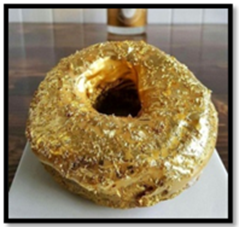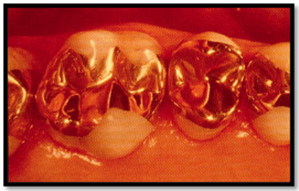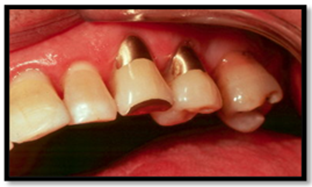Review Article
Gold in Medicine and Dentistry
1Faculty of Dental Medicine and Associated Oral Health Sciences, McGill University, Canada.
2McGill University Queen Elizabeth Hospital, Canada.
*Corresponding Author: Louis Z.G. Touyz,Faculty of Dental Medicine and Associated Oral Health Sciences, McGill University, Canada.
Citation: L.Z.G. Touyz, S.J.J. Touyz. (2023). Gold in Medicine and Dentistry, Dentistry and Oral Health Care, BioRes Scientia Publishers 2(3):1-7. DOI: DOI: 10.59657/2993-0863.brs.23.017
Copyright: © 2023 Louis Z.G. Touyz, this is an open-access article distributed under the terms of the Creative Commons Attribution License, which permits unrestricted use, distribution, and reproduction in any medium, provided the original author and source are credited.
Received: October 09, 2023 | Accepted: October 25, 2023 | Published: October 28, 2023
Abstract
Provenance: Gold as a precious metal is well-known and is enmeshed in many cultural heritages. Besides being used for centuries for jewelry, it was co-opted as coinage. as building material and used in dentistry and medicine.
Aim: This article appraises salient gold characteristics. Reviewed here are (1) gold properties, (2) Human gold physiology, (3) Gold’s current use in medicine, (4) Gold’s nutritional value, and (5) Gold use in dentistry.
Conclusion: Although gold is found in miniscule amounts in the body and has slight anti-inflammatory effects as a salt, gold is still cherished as jewelry, remains chemically inert, is used in dentistry and medicine, has minimal nutritional value, and has scant metabolic function in humans.
Keywords: autotherapy; arthritis; dentistry; chrysotherapy; gold; inflammation; nutrition; pain; physiology; rheumatoid
Introduction
Gold as a pure metal (pure measured as 24 karats) has been known to Mankind for millennia. Examples of worked gold have been found often among many ancient primitive artifacts, jewelry and objects d’art. Examples are found among prehistoric artifacts, and relics found in many ancient burial places from over three thousand years ago. Examples are found in relics from among ancient troglodyte discoveries, through Egyptian antiquities from burial places, to modern treasure troves and depositories like The Royal Crown Jewels in Tudor Castles like The London Tower of Great Britain, and in great museums like the Louvre in Paris France, and collections in The Hermitage of St Petersburg in Russia. Gold is still used today for treasures from common adornments like rings, studs, brooches, bangles and necklaces, to ceremonial mayoral chains, aristocratic coronets, imperial maces, royal regalia, and regal crowns. Gold leaf mosaics were used prolifically in Byzantine art as well as roof covering material for golden domes on buildings.
Figure 1A: Gold mosaic Tiles: A part of a Byzantine figure showing use of small colored mosaics shaping a hand, with use of gold mosaic tiles in the background.
Figure 1B: Gold roof of Les Invalides (Paris France): The gold dome forms the roof of Napoleon Bonoparte’s final resting place in France; The gold retains its shine and does not oxidise when exposed to the atmosphere.
Pure gold relative to gold-alloys, is resistant to oxidation, retains its metallic shine, but is relative to some other metals very soft and abrades easily. Consequently, gold is mixed with various elemental metals to render alloys with desirable qualities of color (green, yellow white and red), resistance to wear, and hardness. Gold when heated binds easily with other metals like copper tungsten or platinum.
Aim: This article appraises salient gold properties. Reviewed here are: (1) Gold properties, (2) Human gold physiology, (3) Gold’s current use in medicine, (4) Gold’s nutritional value, and (5) Gold use in dentistry.
Gold Characteristics and properties
The symbol for Gold in the Atomic Table is: Au (from Latin “aurum” = gold): pure 24 karat gold is also known as ‘Fine gold”. Various karatages exist, but most commercially marketed gold will be 18K, 14K or 9K. Alloys with less than 10 parts of 24 any metal cannot be stamped as gold. The Atomic number of golds is: 79. The Relative Atomic Mass (as in 1977) is: 196.9665; The Freezing Point of gold is: T68 in 0K = 1337.58; and t68 in oC = 1064.43. Tk is the Temperature in Kelvin degrees; t68 is the temperature in oCentigrade [1]. For practical purposes Gold will melt at temperature 1063 0C, and when alloyed to 18Karat the melting point temperature drops into the 0C900s. This feature allows technicians to melt gold and using a wax replacement technique, cast the metal into desirable shapes with utmost accuracy. Also, gold can be easily soldered, annealed and cast. Gold resists acid attack but will dissolve in a mixture of Hydrochloric (HCl) and Nitric (HNO3) acids, known as “Aqua Regia.” Gold is malleable and may be thinned by hammering or pressure rolling into sheets 1/300 000 of an inch thick. Gold takes on and retains a smooth shiny polished surface and is chemically inert. Gold surfaces do not oxidize or ionize, so hardly any chemical, biological coverings or attachments will form on its’ exposed face. Consequently, gold will usually retain its shine for centuries whether exposed to the atmosphere, buried in the ground or under fresh or sea water [1]. Pure metallic fine gold does not undergo chemical, mechanical, electrochemical, and/or mechanical-chemical reaction or change, unless in a chemical molecular salt form.
Human Gold physiology
The exact function of gold in the human body remains obscure. The modulating effect of gold salts on the immune system and inflammatory process has been described, but currently (2023), the precise molecular biology of gold has not been elucidated [2]. Minute amounts of reactive gold salts circulating in the blood will be excreted in the urine over days [5]. See Table 1. Bacteria in the earth have been shown to be able to metabolize heavy metals including gold through what is known as a biogeochemical cycle [7]. If traces of gold may be dissolved, and shifted around with microbes being involved in every step of the process, gut bacteria may also be able to metabolize gold. Rod-shaped Cupriavidus metallidurans was discovered to be able to ingest gold compounds and convert them into elemental metallic form without apparent toxicity to the organism itself [7,3]. It’s quite feasible that gut microbes may be able to metabolize gold and allow gold salts to enter the blood stream.
Figure 1C: Gold is a unique metal because it doesn't rust, even if it's buried in the ground for thousands of years.
Gold use in Medicine
When gold salts are used in medicine as pharmaco-therapy, the use of gold salts is referred to as ‘Chrysotherapy’ and/or ‘Aurotherapy’ [7-10]. Pure metallic gold does not undergo chemical, mechanical, electrochemical, and/or mechanic-chemical unless the metal is in a chemical molecular salt form [7-10]. Miniscule traces [ 10-9 in nano-grams, to 10 -12 in pico-mols] of gold may exist in the diet, and when absorbed into the blood, and in ionized form as a salt, gold is filtered out of the body and is found in urine. Table 1 [6].
Table 1: Gold concentrations found in urine
| pmol/d 56; ± 127 | (range0.05 > 420 pmol) |
| ng/d 11; ±25 | (range0.05 > 83 ng) |
Table 1 At these small concentrations the ranges encountered vary widely. That gold exists in the human body is beyond doubt, but the exact function in health remains obscure. 16 adults were tested, and concentrations measured are recorded as means, ±standard deviations [6].
Gold salts have been used to relieve symptoms arising from rheumatoid arthritis since the mid 1930’s. Gold is not an absolute cure for arthritis, but it does moderate pain derived from active rheumatoid arthritis joint swelling. It also may act prophylactically against future joint degeneration from inflammation. Medicinal gold compounds are manufactured chemical salts that ionize in solution [7,8].
For example: SKF 39162, 1-Thio-β-D-gluco-pyrano-satotriethyl phosphine gold-2,3,4,6-tetra-acetate has the chemical formula: C20H34AuO9PS See Figure 2, and the structural formula is
Figure 2: Bioactive gold salt molecule: 1-Thio-β-D-gluco-pyrano-satotriethyl phosphine gold-2,3,4,6-tetra-acetate: The gold salt is attached to hexagonal organic ring with modified radicals attached, which allows for metabolic activity. (Ref SKF 39162: http://www.enzolifesciences.com/BML-EI206/auranofin).
Why is gold used as gold salts, for managing rheumatoid arthritis (RA)?
Autotherapy with Gold salts are deemed to belong to a class of RA drugs known as DMARDs (disease-modifying anti-rheumatic drugs). Gold-salt therapy alleviates joint pain and swelling in rheumatoid arthritis and these DMARDS prevent further arthritic damage, disability, and morbidity [12-14]. To avoid gastro-intestinal absorption problems intra-muscular injection of gold salts are preferred. Most medications must be given frequently for maximum effect either via self-injection as intra-muscular or intravenous infusion in a doctor's office or hospital. Sodium aurothiomalate (or gold thiomalate GST), and aurothioglucose are other examples of gold salts, and may be administered by injection. Sodium aurothiomalate is an immunosuppressive drug used as an anti-rheumatic. It may be supplemented with auranofin, a modified orally-administered gold salt. Although some reports claim significant improvement of Rheumatoid Arthritis with autotherapy, its use is controversial and is not endorsed by many health care workers [12-14]. Experimentally gold salts have shown promising results in pulmonary disease [16]. In the unlikely event of overdose of gold, a heavy metal antagonist should be administered; drugs like Dimercaprol and Penicillamine and/or Deferoxamine may be used. Many classes of gold-free drugs are used to moderate the metabolic, inflammatory and immune effects of RA. Analgesics, corticosteroids, anti-inflammatories and antihistamines may be used individually or in conjunction with others to obtain relief. Recently different biologically based (without-gold) molecules have equaled or surpassed the success of gold DMARDS in managing Rheumatoid Arthritis; these drugs may be used alone or in combination. (8) They work on various molecular metabolic targets in the inflammatory pathways. Some examples are: Cimzia; Enbrel; Humira; Kineret; Orencia; Remicade; Rituxan; and Simponi. (See Addendum) [15]. Although some success has been recorded with chrysotherapy, there are known side- effects from it. These include thrombocytopenia, exacerbation of the disease, thrombocytosis, dermatitis with an itching skin rash, renal damage, and oral ulcerations affecting the mucosa, gingiva, tongue, and pharynx. Some users will have a sore throat, diarrhea, pyrexia, and other symptoms of infection (sweating, tachycardia), tendencies to bruising or bleeding, and breathlessness. About 1/3 of patients will stop using gold salts because of undesirable side effects. Ongoing monitoring of renal function and blood counts is mandatory when taking gold- salt medication [10-14].
Nutritional Value of Gold
Gold is used as embellishment with baked goods. Most people encounter gold decorations on cakes like wedding cakes and chocolate confections.
Figure 3: A baked doughnut embossed with gold leaf. Photo: @manilasocialclub/Instagram.
Because fine gold is not chemically reactive, it provides no nutritional value. Gold leaf on confectionary is purely for decoration. Consumption of gold may morph into a hedonistic eating food-fad, subject to the ever-changing, sensation-seeking paparazzi fashion industry. Affluent people, who seek novelty for excitement and cheap thrills, are known to have paid $100=00 dollars for an ostentatious gold leaf encrusted doughnut. Figure 3. There is something that attracts fashionistas to the swanky show-off mindset that makes munching gold leaf to be irresistible. The gold leaf passes through the gut virtually intact and is passed out unchanged. Gold has varied in price from $US30 per ounce in 1960 to over US$1900 after the turn of the century. Even though gold can be rendered into ultra-thin sheets (as thin as a miniscule fraction of 1-mm or 1/300 000th of an inch) eating gold as flakes is expensive. No nutritional or health benefits derive from indulging in this extravagance as food. Gold leaf was added as a visual flocculent to alcoholic liqueur. The notorious ‘Danziger Goldwasser’ is an alcoholic herb and spice liqueur (40% alcohol by volume) (Polish: Gdansk vodka, "Vodka of Gdansk"), and ‘Danziger Goldwasser®’ is its registered tradename. ‘Goldwasser’ contains small visible shreds of gold leaf and was originally produced in 1598 until 2009 in Danzig (Gdansk) Poland. The showing-off that a rich roué may drink gold or boast eating it, is nothing more than a socially flamboyant ego-trip with a visual flourish, but there is no gold enhancement of flavor, and no added nutritional value from the gold [4].
Gold use in Dentistry: An overview
Gold was used for millennia in dentistry. In dentistry fine gold had three major disadvantages: its color, its softness and its thermal conductivity. Gold and its alloys’ properties allow for versatile manipulative exploitation to suit demands made by dentistry for durability, resistance to wear and provision of optimal form and function in dentistry. 5 Gold alloyed with silver tends to look green; Gold with platinum or nickel and zinc, tends to look light silver or “white”; “rose gold’ is an alloy with copper and looks pink. Gold alloys improve the hardness and resistance to wear compared to fine gold [5]. Gold used in dentistry is exempt from having to be stamped with caratage. With the exception of gold foil (see below), to avoid abrasion, occlusal attrition and wear, most gold used in dentistry are 18k tungsten zed gold which increases its resistance to wear threefold. Gold is used extensively with confirmative and restorative dentistry, in fixed and removable prosthetics, for splinting, occasionally in orthodontics and for osseous fixation in orthopedics. In dentistry inlays (between cusps), on lays (over one cusp), overlays (over all cusps), ¾ and full coverage crowns may be in gold. Central thimble cores for metal-fused-to-porcelain crowns may also be gold, as can be posts, pins, fixed tooth-born and removable prostheses. Gold reinforced bases for palatal coverage or lower full metal reinforced prostheses also may use a gold alloy for strength against fractures. Gold is a very good thermal conductor which fact often causes post-op heat sensitivity from large gold restorations and crowns in vital teeth. See Figures 4A and 4B.
Figure 4A: Cast-Gold restorations on teeth.
Figure 4B: Gold-restorations done with Gold-foil on teeth.
When under pressure, pure gold foil will bond physically and molecularly at room- or body-temperatures into a unified mass, a property exploited by “the Gold-foil Technique” used in Dentistry. Small very thin rolls of gold are introduced into cavities and progressively enlarged by pressure welding to the desired form. Besides demanding highly skilled techniques and moisture free environments, carefully crafted and designed cavities demand specialized tools (like an automatic mallet, various hand tools with pressing heads, mica-heating trays to burn off particle of dust and holding tweezers) are all needed. The high cost of gold, advanced manual skills demanded, and time needed to successfully execute this, have allowed new quicker, easier alternate restorative techniques and materials, to force this “Gold-foil Technique” into the virtual oblivion of yesteryear, but it is still infrequently used, although pure gold is inert, alloys of gold may act as electrochemical sources when placed in the mouth. The saliva acts as an electrolyte and if other dissimilar metals are placed in the oral cavity, a galvanic electro-chemical circuit may become active. Amalgams of mercury and other reactive metals and dissimilar gold-alloys may produce galvanism. Often galvanism is self-limiting as the reactive ions change chemically. But often symptoms of unexpected pain, mucosal reactions and/or disturbances of taste persist and aggravate to an extent that the only solution is to remove the offending metals and replace them with non-reactive materials. Currently (2023) less expensive materials emulating nature with properties closer to calcified tooth material, demanding easier working skills and techniques are slowly replacing gold in dentistry. Composite resins, dense high-fired porcelains, titanium, and metal-fused-to- porcelain have increased the working palette of dentists and replaced most of gold use. In spite of the expense and visual differences, gold was for centuries and still is among the materials of choice in dentistry [17].
Gold body paint
An urban legend persists that a person will die from suffocation if covered with gold body paint. This arose from a James Bond film (Goldfinger 1964) when “the villain Goldfinger kills character Jill Masterson (played by Shirley Eaton) by covering her in gold paint, causing her death by suffocation an urban legend spread that Eaton actually died on set from asphyxiation from the same gold paint.” However, this is physically impossible, and as of March 2015, Eaton was alive and well. We don't breathe through our skin -- we breathe through our noses and mouths. Accordingly:” Covering your entire body in paint won't cause you to suffocate, no matter what Goldfinger does “ [2,3].The legend is obviously not true, yet the fictional cause of death, as an iconic scene caused general acceptance by the public as medical fact. Although this activity (full bodypainting) is regarded as ultimately safe, a full coat of body paint may be harmful for your health, and caution is advised. A person could induce heatstroke from full-coverage body paint, because the paint blocks the skin-pores and stops corporeal cooling with bodily sweat-mechanisms malfunctioning. Body-painters should only apply paint made for skin-use. Polymerizing acrylic paints are manufactured for application onto absorbent surfaces like linen or canvas and are not meant for bodypainting. Acrylic paints often include ammonia, formaldehyde, heavy metals and other toxic solvents and contents, as part of their paints, all of which may be poisonous if ingested source: [Princeton University: (Princeton EHS @princeton EHS)]. Full body coverage is not advised and should not be sustained for periods longer than half an hour. Toxicity from absorbed or inhaled solvents, may prove to be dangerous, toxic and interfere with healthy body metabolism [2,3].
Conclusion
Gold’s unique properties will continue to fascinate and inspire mankind and will be used in the arts, biomedicine, science and dentistry.
Declarations
Author’s statement: The authors have no conflict of interest to declare.
Ethics and IRB: As no living human or animals were used, no Internal Review Board Certificate is needed.
Funding: This is a spontaneous article: No finance was solicited or received for this article.
Addendum
Mode of action and suppliers of molecular drugs mentioned
Cimzia: (A humanized antibody Fab’ Fragment specific for TNFα); By UCB Canada Inc.
Enbrel: (A ligand-binding portion of TNF-Receptor and Fc part of IgG1); by Immunex Corporation 7 Amgen Inc.
Humira: (A blocking anti-body against TNFα); by Humira.
Kineret: AKA Anakinra: a man-made form of a natural protein (interleukin-1 receptor antagonist) made by the body; by Kineret.
Orencia: (selectively modulates a key co-stimulatory signal required for full activation of Lymphocytes expressing CD28); by Bristol Meyers Squib.
Remicade: (A TNF blocker); by Rexall Pharma Plus.
Rituxan: (A monoclonal antibody; contra-indicated with live viral vaccines); by Rituxan.
Simponi: Tumor necrosis factor alpha (TNFα) inhibitor); by Janssen.
References
- Garrison W.E. David M.E. In: Handcrafting Jewelry. (1972). Ch16. Materials, 161-181. ISBN 0 7093 48402. Robert Hale & Co. London UK.
Publisher | Google Scholor - Jenkinson H. (2017).
Publisher | Google Scholor - Rothman L. (2012).
Publisher | Google Scholor - Shott C (2016) Does Eating Gold Provide Any Nutritional Value? Healthy Living; Food Republic.
Publisher | Google Scholor - Phillips R.W. (1982) in: Skinner’s Science of Dental Materials. Passim. W.B. Saunders.
Publisher | Google Scholor - Lentner C. (1981) In: Geigy Scientific Tables; Lentner C. Editor; Eighth revised ed. 1(20): 52-61
Publisher | Google Scholor - Wiesemann N, Bütof L, Herzberg M, et al (2017). Synergistic toxicity of copper and gold compounds in Cupriavidus metallidurans. Appl Environ Microbiol, 83: 01679-17.
Publisher | Google Scholor - Hu M., Zhang Z., Liu B., Zhang S., et al. (2018). Deubiquitinase Inhibitor Auranofin Attenuated Cardiac Hypertrophy by Blocking NF-κB Activation. Cell Physiol Biochem, 45(6):2421-2430.
Publisher | Google Scholor - Griffin AJ, Gibson T, Huston G, Taylor A. (1981). Maintenance chrysotherapy in rheumatoid arthritis: a comparison of 2 dose schedules. Ann Rheum Dis, 40(3):250-253.
Publisher | Google Scholor - Srinivisa P., Miller B.L., Pauka H.E. (1979). Long term chrysotherapy in rheumatoid arthritis. Arthritis Rheummatol, 22:105-110.
Publisher | Google Scholor - Vlak T., Jajic I. (1992). Side effects of gold salt in patients with rheumatoid arthritis. Rheumatizam, 39(2):25-28.
Publisher | Google Scholor - Williams H.J., Ward J.R. (1992). Comparison of oral and parenteral gold therapy and placebo in the treatment of rheumatoid arthritis. Scand Rheumatol, 51:92-99.
Publisher | Google Scholor - Williams H.J., Ward J.R., Egger M.J., Reading J.C., Samuelson C.O. et al. (1984). Auranofin, gold sodium thiomalate, and placebo in the treatment of rheumatoid arthritis. Cooperative systematic studies of rheumatic diseases. Clin Rheumatol. 3(1):39-50.
Publisher | Google Scholor - Cui Y., Zhao Y., Tian Y., et al. (2012). The molecular mechanism of action of bactericidal gold nanoparticles on Escherichia coli. Biomaterials, 33(7):2327-33
Publisher | Google Scholor - Slavin Y.N., Asnis J., Häfeli U.O., Bach H. (2017). Metal nanoparticles: understanding the mechanisms behind antibacterial activity. J Nanobiotechnology, 15(1):65.
Publisher | Google Scholor - Britt R.D., Velten M., Locy M.L., Lynette K., Tipple R. & T. (2024). The Thioredoxin Reductase-1 Inhibitor Aurothioglucose Attenuates Lung Injury and Improves Survival in a Murine Model of Acute Respiratory Distress Syndrome. Antioxidants & Redox Signaling, 2681-2691.
Publisher | Google Scholor - Dental Gold Institute. (1982). Gold the material odd Choice in Dentistry. Position paper.20 Park Plaza # 463; Boston Ma 02116: USA.
Publisher | Google Scholor






















